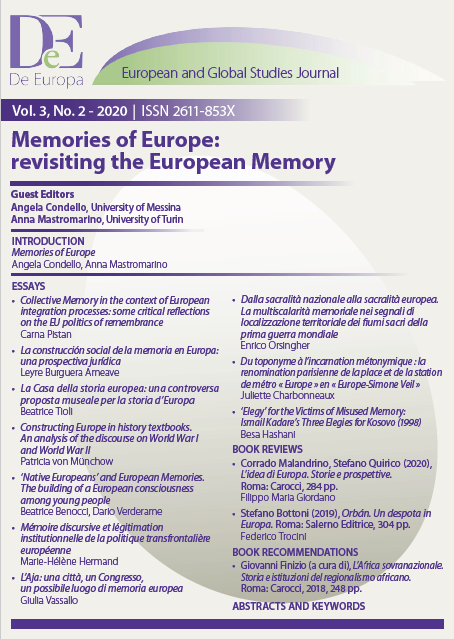L’Aja: una città, un Congresso, un possibile luogo di memoria europea
Abstract
In un dibattito storiografico in cui al concetto di memoria e di luogo di memoria viene riservato uno spazio progressivamente più ampio, una riflessione sulla cosiddetta memoria europea è apparsa, a molti, almeno doverosa. In tale contesto, tuttavia, poco spazio risulta ancora riservato a un evento come il Congresso dell’Europa, meglio noto come Congresso dell’Aja, dal nome della capitale istituzionale dei Paesi Bassi che lo ospitò, dal 7 al 10 maggio 1948. Tale evento sembra invece costituire un momento di grande significato per la costruzione di una memoria europea, sia in quanto luogo fisico di memoria, ovvero simbolo ben riconoscibile e collettivamente identificabile di condivisione di momenti e processi, sia sul piano dell’eredità valoriale ad esso connessa. Partendo da tali presupposti, e avvalendosi delle fonti e della pubblicistica nederlandese dell’epoca come principali strumenti di indagine, la riflessione che segue intende, in primo luogo, puntare l’accento sugli obiettivi perseguiti dagli organizzatori del Congresso europeista, con specifico riferimento alla creazione di una opinione pubblica europea ben consapevole e strutturata attorno ai principi e ai valori enunciati all’Aja. In secondo luogo, si intende verificare se, e in quale misura, il complesso del Binnenhof - e più precisamente la Ridderzaal, in cui si celebrarono i momenti più significativi e prestigiosi del Congresso - possa ambire a simbolo riconosciuto e riconoscibile dell’effettiva volontà europea, manifestatasi nel maggio del 1948, sia di superare le antiche divisioni interstatali, sia di intraprendere un cammino irreversibile di unità e solidarietà.
Parole chiave: Storia e Memoria, Pubblicistica e fonti olandesi, Congresso dell’Aja, Luogo di memoria, Identità europea.
In a historiographical debate in which a progressively wider space is reserved for the concept of memory and places of memory, a reflection on the so-called European memory appeared necessary. However, in this context little space is still reserved for an event such as the Congress of Europe, better known as The Hague Congress, named after the institutional capital of the Netherlands that hosted it, from 7 to 10 May 1948. This event, on the other hand, seems to be a moment of great significance for the construction of a European memory, both as a physical place of memory, that is to say a well-recognized and collectively identifiable symbol of sharing moments and processes, and in terms of the inheritance of values connected to it. Starting from these assumptions, and using the Dutch sources and publications of the time as the main investigative tools, the following contribution aims, first of all, to focus on the objectives pursued by the organizers of The Hague Congress, with specific reference to the creation of a European public opinion well aware and structured around the principles and values set out in The Hague. Secondly, we intend to verify whether, and to what extent, the Binnenhof complex - and more precisely the Ridderzaal, which hosted the most significant and prestigious moments of the Congress - can aspire to a recognized and recognizable symbol of the concrete European will, which manifested itself in May 1948, both to overcome the ancient interstate divisions, and to undertake an irreversible path of unity and solidarity.
Keywords: History and Memory, Dutch publications and archival sources, The Hague Congress, Place of memory, European identity.



 The journal has been approved for inclusion in DOAJ. The DOAJ listing of the journal is available at
The journal has been approved for inclusion in DOAJ. The DOAJ listing of the journal is available at 
